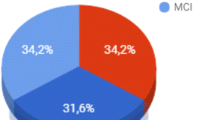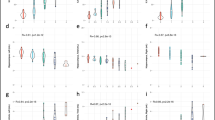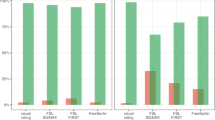Abstract
Objectives
Validate the four-point visual rating scale for posterior cortical atrophy (PCA) on magnetic resonance images (MRI) through quantitative grey matter (GM) volumetry and voxel-based morphometry (VBM) to justify its use in clinical practice.
Methods
Two hundred twenty-nine patients with probable Alzheimer’s disease and 128 with subjective memory complaints underwent 3T MRI. PCA was rated according to the visual rating scale. GM volumes of six posterior structures and the total posterior region were extracted using IBASPM and compared among PCA groups. To determine which anatomical regions contributed most to the visual scores, we used binary logistic regression. VBM compared local GM density among groups.
Results
Patients were categorised according to their PCA scores: PCA-0 (n = 122), PCA-1 (n = 143), PCA-2 (n = 79), and PCA-3 (n = 13). All structures except the posterior cingulate differed significantly among groups. The inferior parietal gyrus volume discriminated the most between rating scale levels. VBM showed that PCA-1 had a lower GM volume than PCA-0 in the parietal region and other brain regions, whereas between PCA-1 and PCA-2/3 GM atrophy was mostly restricted to posterior regions.
Conclusions
The visual PCA rating scale is quantitatively validated and reliably reflects GM atrophy in parietal regions, making it a valuable tool for the daily radiological assessment of dementia.
Key Points
• Visual rating scale reflects grey matter atrophy in posterior brain regions.
• Different PCA scores corresponded well to different quantitative degrees of atrophy.
• Inferior parietal gyrus volume influenced assessment based on the visual rating scale.
• This simple visual rating scale makes it useful for radiological dementia assessment.




Similar content being viewed by others
Abbreviations
- AD:
-
Alzheimer’s disease
- PCA:
-
Posterior cortical atrophy
- VBM:
-
Voxel-based morphometry
- MTA:
-
Medial temporal lobe atrophy
- GCA:
-
Global cortical atrophy
- TIV:
-
Total intracranial volume
- FWE:
-
Family-wise error
- ROI:
-
Region of interest
- WMH:
-
White matter hyperintensities
- CSF:
-
Cerebrospinal fluid
- WM:
-
White matter
- GM:
-
Grey matter
References
Scheltens P, Fox N, Barkhof F, DeCarli CD (2002) Structural magnetic resonance imaging in the practical assessment of dementia: beyond exclusion. Lancet Neurol 1:13–21
Sluimer JD, Vrenken H, Blankenstein MA et al (2008) Whole-brain atrophy rate in Alzheimer disease: identifying fast progressors. Neurology 70:1836–1841
Karas G, Scheltens P, Rombouts S et al (2007) Precuneus atrophy in early-onset Alzheimer's disease: a morphometric structural MRI study. Neuroradiology 49:967–976
Benson DF, Davis RJ, Snyder BD (1988) Posterior cortical atrophy. Arch Neurol 45:789–793
Jacobs HI, Van Boxtel MP, Uylings HB, Gronenschild EH, Verhey FR, Jolles J (2011) Atrophy of the parietal lobe in preclinical dementia. Brain Cogn 75:154–163
Lehmann M, Rohrer JD, Clarkson MJ et al (2010) Reduced cortical thickness in the posterior cingulate gyrus is characteristic of both typical and atypical Alzheimer's disease. J Alzheimers Dis 20:587–598
Lehmann M, Koedam EL, Barnes J et al (2012) Posterior cerebral atrophy in the absence of medial temporal lobe atrophy in pathologically-confirmed Alzheimer's disease. Neurobiol Aging 33:627.e1–627.e12
Koedam EL, Lehmann M, van der Flier WM et al (2011) Visual assessment of posterior atrophy development of a MRI rating scale. Eur Radiol 21:2618–2625
Scheltens P, Launer LJ, Barkhof F, Weinstein HC, van Gool WA (1995) Visual assessment of medial temporal lobe atrophy on magnetic resonance imaging: interobserver reliability. J Neurol 242:557–560
Bresciani L, Rossi R, Testa C et al (2005) Visual assessment of medial temporal atrophy on MR films in Alzheimer's disease: comparison with volumetry. Aging Clin Exp Res 17:8–13
Davies RR, Scahill VL, Graham A, Williams GB, Graham KS, Hodges JR (2009) Development of an MRI rating scale for multiple brain regions: comparison with volumetrics and with voxel-based morphometry. Neuroradiology 51:491–503
McKhann G, Drachman D, Folstein M, Katzman R, Price D, Stadlan EM (1984) Clinical diagnosis of Alzheimer's disease: report of the NINCDS-ADRDA Work Group under the auspices of Department of Health and Human Services Task Force on Alzheimer's Disease. Neurology 34:939–944
Petersen RC, Stevens JC, Ganguli M, Tangalos EG, Cummings JL, DeKosky ST (2001) Practice parameter: early detection of dementia: mild cognitive impairment (an evidence-based review). Report of the Quality Standards Subcommittee of the American Academy of Neurology. Neurology 56:1133–1142
Fazekas F, Chawluk JB, Alavi A, Hurtig HI, Zimmerman RA (1987) MR signal abnormalities at 1.5 T in Alzheimer's dementia and normal aging. AJR Am J Roentgenol 149:351–356
Pasquier F, Leys D, Weerts JG, Mounier-Vehier F, Barkhof F, Scheltens P (1996) Inter- and intraobserver reproducibility of cerebral atrophy assessment on MRI scans with hemispheric infarcts. Eur Neurol 36:268–272
Jenkinson M, Smith S (2001) A global optimisation method for robust affine registration of brain images. Med Image Anal 5:143–156
Alemán-Gómez Y, Melie-García L, Valdés-Hernandez P (2006) IBASPM: toolbox for automatic parcellation of brain structures. Presented at the 12th Annual Meeting of the Organization for Human Brain Mapping, Florence, Italy. Available on CD-Rom in. 27 ed, 2006. 11-15 June
Tzourio-Mazoyer N, Landeau B, Papathanassiou D et al (2002) Automated anatomical labeling of activations in SPM using a macroscopic anatomical parcellation of the MNI MRI single-subject brain. Neuroimage 15:273–289
Ashburner J (2007) A fast diffeomorphic image registration algorithm. Neuroimage 38:95–113
Frisoni GB, Pievani M, Testa C et al (2007) The topography of grey matter involvement in early and late onset Alzheimer's disease. Brain 130:720–730
Barnes J, Godbolt AK, Frost C et al (2007) Atrophy rates of the cingulate gyrus and hippocampus in AD and FTLD. Neurobiol Aging 28:20–28
Acknowledgements
The gradient non-linearity correction was kindly provided by GE Medical Systems, Milwaukee, WI, USA. Christiane Möller is appointed on a grant from the national project ‘Brain and Cognition’ [“Functionele Markers voor Cognitieve Stoornissen” (# 056-13-001)]. Wiesje van der Flier is recipient of the Alzheimer Nederland grant (Influence of age on the endophenotype of AD on MRI, project no. 2010-002). Research of the VUmc Alzheimer Centre is part of the neurodegeneration research programme of the Neuroscience Campus Amsterdam. The Alzheimer Centre VUmc is supported by Alzheimer Nederland and Stichting VUmc fonds. The clinical database structure was developed with funding from Stichting Dioraphte. All patients were also included in a recent paper on grey matter differences between early- and late-onset Alzheimer’s disease with an unrelated use of the same imaging data.
All patients were also included in a recent paper on grey matter differences between early- and late-onset Alzheimer’s disease with an unrelated use of the same imaging data (Möller et al. Different patterns of grey matter atrophy in early- and late-onset Alzheimer's disease. Neurobiol Aging 2013; 34:2014-2022 PubMed).
Author information
Authors and Affiliations
Corresponding author
Rights and permissions
About this article
Cite this article
Möller, C., van der Flier, W.M., Versteeg, A. et al. Quantitative regional validation of the visual rating scale for posterior cortical atrophy. Eur Radiol 24, 397–404 (2014). https://doi.org/10.1007/s00330-013-3025-5
Received:
Revised:
Accepted:
Published:
Issue Date:
DOI: https://doi.org/10.1007/s00330-013-3025-5




